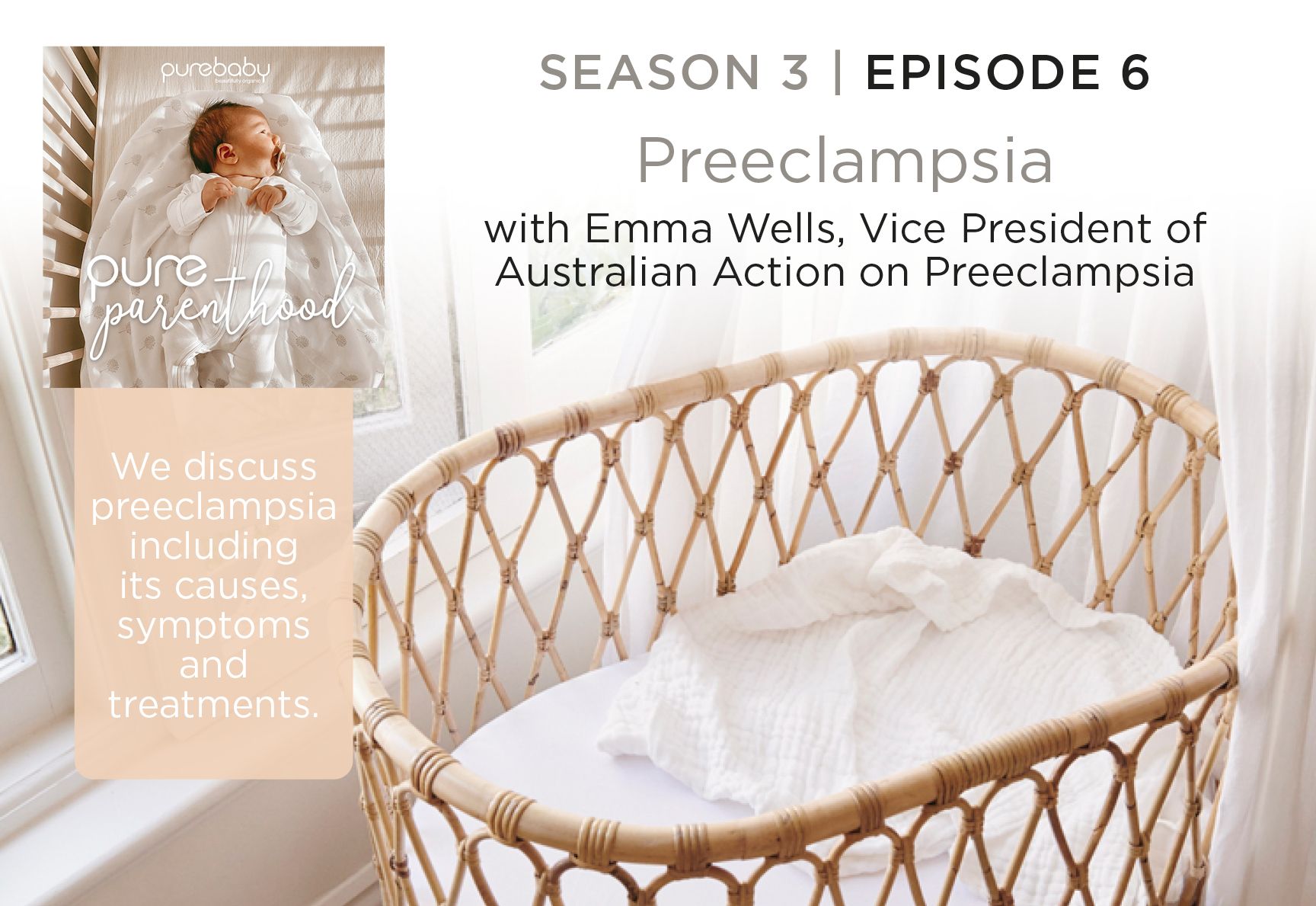What is Preeclampsia?
7 min read | 27 March 2022

In this episode we are joined by Emma Wells, Vice President of Australian Action on Pre-eclampsia (AAPEC). We discuss Preeclampsia, including its causes, symptoms and treatment options.
Listen to Season 3, Episode 6 above or on Apple Podcasts or Spotify.
*Trigger warning: Please be aware that this episode contains content about infant loss and may be triggering to those who have experienced this.
What is preeclampsia?
Preeclampsia is an illness, which only occurs in pregnancy. It results in high blood pressure (hypertension), leakage of protein into the urine (proteinuria), thinning of the blood (coagulopathy), and liver dysfunction. This illness also slows the growth of your baby.
It is the most common serious medical disorder of human pregnancy. If left untreated, preeclampsia can lead the mother to liver or kidney failure, seizures, stroke and death. For the baby, preeclampsia can affect the placenta and decrease the fetal supply of oxygen and food, leading to slower growth in the womb, a low birth weight, premature birth and in some cases, death. Warning signs surface in the latter half of pregnancy, usually from 20 weeks.
Common symptoms of preeclampsia:
High blood pressure
Protein in urine
Excessive swelling (Oedema) hands, feet and face
Severe headaches
Visual disturbances (such as flashing lights, blurred vision)
Vomiting and pain in the upper abdomen
Difficulty breathing
Liver and kidney dysfunction
What causes preeclampsia?
The precise cause of preeclampsia is unknown. However, it is believed that genetic factors are involved, given that women whose mothers and/or sisters have suffered preeclampsia are at increased risk of the disease themselves.
There is good evidence that the placenta is centrally involved in the development of preeclampsia. The placenta is a specialised organ that forms in the uterus during pregnancy. It receives blood from the mother and transfers oxygen and nutrition from the mother across to the baby’s circulation, thereby helping the baby to grow and develop.
It seems that in preeclampsia, the placenta does not receive sufficient maternal blood for its requirements, which results in a malfunction within the placental tissue. This malfunction produces factors that pass from the placenta back into the mother’s circulation.
Risk factors for preeclampsia in pregnant women:
Having their first baby
Having a history of preeclampsia in a previous pregnancy
Family history of preeclampsia or high blood pressure
Under the age of 20 and over the age of 40
Having twins or multiples
Those with high blood pressure before pregnancy
Those with kidney disease before pregnancy
Those with diabetes
Having a body mass index (BMI) over 30
Diagnosis of preeclampsia
Women should always report worrying signs or symptoms to their doctor during pregnancy. Often there may turn out to be no cause for alarm, but it is a simple matter to have a blood pressure measurement, a urine check, a blood test or other investigations or examinations to be sure that preeclampsia or some other pregnancy complication is not the cause of the symptoms or signs of concern.
The development of preeclampsia can best be detected by routine screening tests carried out at antenatal check-ups. A combination of rising blood pressure and protein in the urine suggests preeclampsia may be developing, although there are some other medical disorders that can give a similar picture. It is vital to attend all of your antenatal appointments and always seek medical help if you feel or sense that something is not right.
If a previously healthy pregnant woman develops high blood pressure and proteinuria in the latter half of her pregnancy, then the diagnosis is almost always preeclampsia. Some swelling (oedema) is common in normal pregnancy, but excessive swelling which also involves the face can occur in preeclampsia. In severe preeclampsia, symptoms can appear, including severe headaches, visual disturbances (such as flashing lights, blurred vision), vomiting and pain in the upper abdomen. While such symptoms may have other less dangerous causes, they should never be ignored during pregnancy.
Preeclampsia testing
Routine screening tests at antenatal appointments:
Blood pressure checks
Urine tests (measuring protein in urine)
Tests not yet widely available in Australia:
Early Pregnancy Prediction Test:
Early screening using ultrasound and blood tests at 11–14 weeks of pregnancy.
The Preeclampsia Ratio Test
– known as the
PERT
test in the latter half of pregnancy. As well as quickly diagnosing the condition by measuring proteins in the blood, it predicts whether or not these women are going to develop preeclampsia in the subsequent four weeks.
Preeclampsia treatment
You and your baby will be closely monitored by your health care professional. If symptoms worsen, you will be admitted to hospital for bed rest, further monitoring and medical intervention if required.
If severe preeclampsia sets in, early delivery is required to save mother and baby. In fact, the only cure for preeclampsia is delivery of the baby and placenta. If you are considered to be at high risk of developing preeclampsia, you will be prescribed a low dose aspirin starting in early pregnancy e.g. 8-16 weeks to significantly reduce their risk of disease, particularly early-onset and preterm preeclampsia.
Download the episode transcript here.
This article was written by Emma Wells in conjunction with Season three, episode 6 of Purebaby’s podcast, Pure Parenthood.
For more information on preeclampsia and AAPEC, you can head to their website here.
Please remember to always consult a medical professional first for their advice on diagnosis and treatment.



